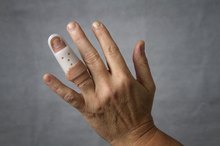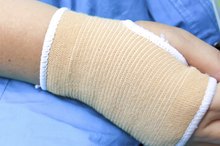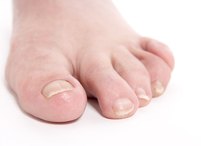How to Reduce Swelling in the Fingers After an Animal Bite Infection
Animal bites are a common occurrence, particularly among children. According to the American Society for Surgery of the Hand, dogs cause the majority of animal bites in the United States 1. Other animals that bite humans include cat, rodents and farm animals. The greatest health risk after an animal bite is the possibility of infection. Cat bites have the greatest potential for infection because their sharp teeth burrow deep into the tissue. One of the first signs of an infected animal bite is swelling at the site, such as the finger. Several strategies can reduce the swelling of an infected animal bite to the finger and decrease the potential for complications.
Recognize the Symptoms of Infection
The mouths of animals are populated with a wide array of germs. When introduced to a body through a bite, these bacteria can seed the tissues and begin to grow, resulting in an infection. The hand and the fingers have a high risk of infection following an animal bite. This is due to the complicated anatomy and the relatively poor blood supply to some of the deep tissue structures. The depth of the wound determines the type of infection. Surface bites or scratches can cause cellulitis, an infection of the superficial skin layers. A deeper bite can infect the tendons or bones of the finger. Signs of infection include swelling, redness and pus at the site of the bite; red streaks extending from the wound; decreased mobility and pain of the finger; and loss of circulation due to the swelling, which can make the finger appear pale or blue. Fevers, night sweats, chills and loss of sensation to the fingers indicate a serious infection.
Recovering From Finger Surgery
Learn More
Start treatment early to minimize swelling. The most important step in preventing swelling and infection of the finger after an animal bite is thorough cleansing of the wound. According to the LSU School of Veterinary Medicine, clean the wound with copious amounts of warm water and soap for about five minutes immediately after the bite to remove dirt and saliva that contain bacteria 2. If the wound is bleeding, direct pressure with a clean cloth or gauze and elevation of the finger can help control swelling. Gently scrubbing the wound will help decrease the possibility of swelling due to infection. The risk of swelling may likewise be reduced by application of an antiseptic solution or antibiotic ointment after washing. Anti-inflammatory medications, such as ibuprofen, help control the swelling of mild infections, and treat pain and fever. Prevent reinfection of the wound by covering it with a sterile dressing or bandage.
Avoid complications of swelling. To minimize the swelling and avoid complications of the bite, doctors may need to order tests to assess the tissue damage. X-rays can determine if there is bone trauma as a result of the bite. Other studies such as magnetic resonance imaging, or MRI, can identify damage to the tendons and help your physician diagnose osteomyelitis, or bone infection. Significant swelling may require surgical intervention to decrease the pressure within the finger and properly clean the infection out of the deeper tissues. According to the American Society for Surgery of the Hand, surgical exploration also helps remove dead tissue, damaged skin and clots that can interfere with the healing process 1. Antibiotics may be necessary to decrease the swelling and control the infection. A prolonged course of intravenous antibiotics is sometimes prescribed to treat deep tissue infections such as osteomyelitis that can cause significant swelling. Damage to the tendons typically requires surgery by a hand specialist.
Tips
If you sustain an animal bite, seek advice from your physician to reduce the risk for serious complications that can arise from infection.
- The mouths of animals are populated with a wide array of germs.
- Surface bites or scratches can cause cellulitis, an infection of the superficial skin layers.
- If the wound is bleeding, direct pressure with a clean cloth or gauze and elevation of the finger can help control swelling.
Related Articles
Writer Bio
Ruben J. Nazario has been a medical writer and editor since 2007. His work has appeared in national print and online publications. Nazario is a graduate of the University of Louisville School of Medicine, and is board-certified in pediatrics. He also has a Master of Arts in liberal studies from Skidmore College in Saratoga Springs, N.Y.









